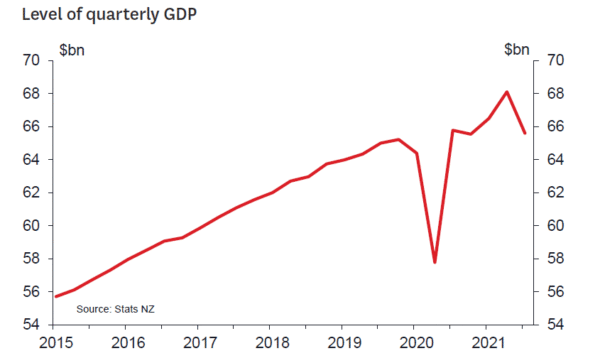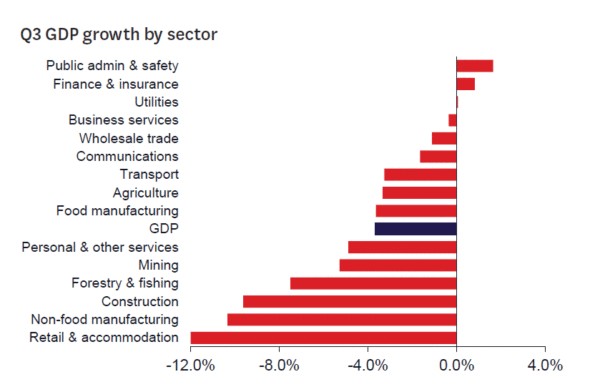- GDP fell by 3.7% in the September quarter, following a 2.4% rise in June.
- The details point to Covid-related activity restrictions as the main driver for the decline in economic output, rather than weakness in demand.
- Today’s results don’t change the outlook for either monetary or fiscal policy. Activity is expected to bounce back in the coming quarters, as Covid restrictions are eased and pent-up demand is unleashed.
New Zealand’s GDP fell by 3.7% in the June quarter. The result was weaker than our forecast of a 3% fall, but well within the range of possibilities in this Covid-affected environment. The average market forecast was similar at around 4%.
Today’s release doesn’t alter our view on the economy as a whole. Activity is still expected to bounce back over the next few quarters, driven by pent-up demand. However, we won’t see the same V-shaped recovery as last year, as parts of the country have still been under Covid restrictions throughout the December quarter.
Similarly, we don’t think that these results challenge the outlook for monetary or fiscal policy. While both the Reserve Bank and the Treasury had assumed a fall of around 6-7%, their forecasts were finalised in November, before many of the inputs for GDP were available. And while both assumed a sharp decline, they also expected a full rebound in the following quarters – and that aspect of their forecasts won’t need to change.
Details
The 3.7% fall in the September quarter followed a strong 2.4% rise in the June quarter. What surprised us was the magnitude rather than the drivers in today’s results. Putting it together, the level of GDP is still 0.6% higher than it was at the end of 2019, before the pandemic. Given the headwinds that have been buffeting the economy (including the loss of international tourist dollars) that resilience points to ongoing firmness in underlying demand.
The sectors that saw the largest decline in the September quarter were customer-facing services, where shutdowns and social distancing restrictions were a particularly large drag on activity. That includes retail trade and accommodation, arts and recreation, and other personal services. These were also the biggest source of uncertainty in our forecasts, as Stats NZ has had to use alternative data sources and methods to capture the lockdown impact for these sectors in particular.
Sectors that were relatively unaffected by Covid restrictions in the September quarter were mostly in line with our forecast. That includes financial services, rental hiring and real estate services and utilities. Professional services in general fared much better than the lockdown in 2020. While that was in part due to the country as a whole spending less time in Alert Level 4 than in 2020, businesses were also better prepared to work remotely this time. As a result, the reimposition of lockdown conditions was less of a brake on activity.
Today’s results also included revisions from Stats NZ as part of the usual annual benchmarking exercise (which accounts for better data on economic conditions becoming available over time). Those revisions have left us with a slightly stronger picture for GDP over the past year, which is consistent with indications that the New Zealand economy as a whole has been fairly resilient to the Covid outbreak, those there are obviously some sectors which continue to wrestle with tough operating conditions.
Outlook
While today’s result was a little lower than our forecast, the economy has come through the Delta outbreak (thus far) in better shape than we feared back in August. Businesses are now adapting to operating with health restrictions. The labour market remains in good health and domestic demand has remained robust. Spending levels having picked up as the Alert Level has been dialled down.
Overall, we continue to expect a return to firm levels of demand over the coming year. That’s despite the ongoing headwinds like the closure of the border and the uncertainty stemming from the emergence of the Omicron variant. Importantly, that also means that we don’t expect any relief from the strong capacity and inflation pressures that the economy is confronting 
















